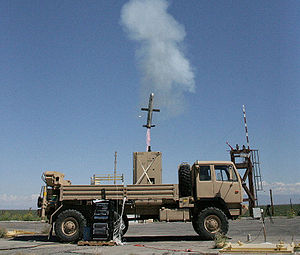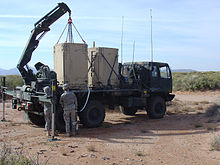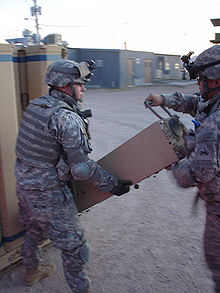- XM501 Non-Line-of-Sight Launch System
-
Non-Line of Sight Launch System 
NLOS missile launching from a CLU on the back of a truckType Self-contained missile launch system Place of origin  United States
United StatesProduction history Designer Lockheed Martin and Raytheon Unit cost US$466,000 per missile Produced Canceled Specifications Weight 3,150 lb (1.58 short tons; 1.41 long tons) Length 45 in (1.1 m) Width 45 in (1.1 m) Height 78 in (2.0 m) Launch
platformCLU of 15 canistered missiles on truck, ship or ground The Non-Line of Sight Launch System (NLOS-LS) was a self-contained missile launcher system that was under development by NETFIRES LLC, a partnership between Lockheed Martin and Raytheon. Each Container Launch Unit (CLU) holds 15 missiles, and a self-locating networked communications system. CLUs can be linked for coordinated launching, with the missiles fired and controlled remotely via autonomous vertical launch. The weapon is roughly 2 meters tall.
The program was canceled early 2011. It was being developed for the United States Navy's Littoral Combat Ship, but has been criticised for performance issues. The Griffin missile has been recommended for use instead. NLOS-LS was to be use primarily on the United States Army's Future Combat Systems before it was canceled.
Contents
Concept
There were to be two types of missile used with NLOS-LS: the Precision Attack Munition (PAM) and the Loitering Attack Munition (LAM). The LAM was originally contracted to Lockheed Martin Missiles and Fire Control, but the contract was terminated after costs rose and tests went poorly.[citation needed] As it stands now, the PAM is the only armament currently being designed for the NLOS-LS.[1]
- Height: 69 in (1,800 mm)
- Length: 11 in (280 mm)
- Width: 11 in (280 mm)
Precision Attack Munition (PAM)
Used to attack vehicles, armor, bunkers, and other targets of opportunity. Uses 3 modes of guidance, GPS/INS, semi-active laser homing, and autonomous imaging infrared. Carries a multi-mode warhead effective against several types of targets. It also includes an online library of pictures of targets, so that it can visually identify what it is homing in on.
Specifications
- Weight: 117 lb (53 kg)
- Diameter: 7 in (180 mm)
- Length: 60 in (1,500 mm)
- Guidance: GPS/INS, imaging infrared, semi-active laser homing.[2]
- Datalink: Networked for in-flight updates, retargeting and images.
- Motor: Variable thrust rocket motor.
- Range: 25 mi (40 km)
Loitering Attack Munition (LAM)
Designed to fly to a preset area and loiter while autonomously seeking out targets.
Specifications
- Weight: 117 lb (53 kg)
- Diameter: 7 in (180 mm)
- Length: 60 in (1,500 mm)
- Guidance: GPS/INS, laser radar (LADAR) seeker with automatic target recognition.[2]
- Datalink: Networked for in-flight updates, retargeting and images.
- Motor: Micro turbojet.
- Range: 45 mi (72 km) with 30 min loiter time.
Development
- November 2002 – First guided flight of Precision Attack Missile.[3]
- December 2005 – Successful Loitering Attack Missile Boost Test Vehicle (BTV) flight test at Eglin Air Force Base, FL.[4]
- April 2007 – Successful test launch of a Precision Attack Missile from a CLU at White Sands Missile Range.[5]
- June 2007 – Successful test of Precision Attack Missile warhead against a fortified bunker.[6]
- November 2008 – Successful first test of Precision Attack Missile fired from Container Launch Unit. Scores hit on T-72 tank.[7]
- May 2009 – Captive flight test clears way for over-water flights to test capability against small boats.[8]
- Feb 2010 – Four out of six missiles fail to hit their targets in a Limited User Test.[9]
- April 2010 – US Army calls for program to be canceled.[10]
- 3 May 2010 – The U.S. Army removes the system from their website.[11]
- 12 May 2010 – House Armed Services seapower and expeditionary forces subcommittee moves R&D funding to Navy budget.[12]
- 18 May 2010 – Defense Department approved an Army recommendation to cancel the program[13]
- 6 Jan 2011 – DefSec Gates announces end of program.[14]
- 2012 – US Navy was to begin at-sea testing of LCS surface missile module.[15]
See also
The JUMPER missile system from Israel Aerospace Industries uses a similar concept, but with 8 missiles instead of 15 and without the IR seeker.[16]
References
- ^ NLOS-LS product sheet[dead link]
- ^ a b "Raytheon PAM Lockheed Martin LAM (NetFires NLOS-LS) - Designation Systems". http://www.designation-systems.net/dusrm/app4/netfires.html.
- ^ "Raytheon Precision Attack Missile makes first guided flight - Raytheon PR". Raytheon.com. 2002-11-18. http://www.raytheon.com/newsroom/briefs/111802.htm. Retrieved 2011-05-27.
- ^ Lockheed Martin, Netfires Llc Successfully Conduct Loitering Attack Missile Boost Vehicle Test - Lockheed Martin PR[dead link]
- ^ NetFires LLC Precision Attack Missile Launch Paves the Way for Complete System Testing - Netfires LLC PR
- ^ John Pike (2007-06-28). "NetFires LLC Conducts Successful Warhead Demonstration for Precision Attack Missile - NetFires LLC PR". Globalsecurity.org. http://www.globalsecurity.org/military/library/news/2007/06/mil-070628-raytheon01.htm. Retrieved 2011-05-27.
- ^ "NLOS-LS Team Completes First Test Of Missile Fired From Container Launch Unit". Spacewar.com. http://www.spacewar.com/reports/NLOS_LS_Team_Completes_First_Test_Of_Missile_Fired_From_Container_Launch_Unit_999.html. Retrieved 2011-05-27.
- ^ "NetFires NLOS-LS makes advancement". Upi.com. 2009-05-05. http://www.upi.com/Security_Industry/2009/05/05/NetFires-NLOS-LS-makes-advancement/UPI-88481241551622/. Retrieved 2011-05-27.
- ^ "Challenges Ahead For NLOS-LS". Aviationweek.com. 2010-02-26. http://www.aviationweek.com/aw/generic/story_generic.jsp?channel=aerospacedaily&id=news/asd/2010/02/26/07.xml&headline=Challenges%20Ahead%20For%20NLOS-LS. Retrieved 2011-05-27.
- ^ "Army asks to cancel NLOS-LS". Armytimes.com. 2010-04-23. http://www.armytimes.com/news/2010/04/defense_NLOS_axed__042610/. Retrieved 2011-05-27.
- ^ "Army modernization | Capabilities". Bctmod.army.mil. http://www.bctmod.army.mil/systems/index.html. Retrieved 2011-05-27.
- ^ "Committee shifts NLOS R&D funding to Navy". Armytimes.com. 2010-05-12. http://www.armytimes.com/news/2010/05/military_army_navy_nlos_funding_051210w/. Retrieved 2011-05-27.
- ^ Corrin, Amber (2010-05-14). "Embattled missile program meets its demise". Defensesystems.com. http://defensesystems.com/articles/2010/05/14/army-cancels-launch-system.aspx?s=ds_190510&admgarea=TC_DEFENSE. Retrieved 2011-05-27.
- ^ ""Gates Reveals Budget Efficiencies, Reinvestment Possibilities."". Defense.gov. http://www.defense.gov//News/NewsArticle.aspx?ID=62351. Retrieved 2011-05-27.
- ^ "Army NLOS Dead. Will the Navy Keep it Alive?". Defense-update.com. http://www.defense-update.com/features/2010/april/nlos_ls_navy_24042010.html. Retrieved 2011-05-27.
- ^ "IAI Unveils JUMPER Missile for Urban Warfare". Israelnationalnews.com. http://www.israelnationalnews.com/News/News.aspx/133272. Retrieved 2011-05-27.
External links
- Non Line of Sight-Launch System - Lockheed Martin
- NetFires NLOS-LS - Designation Systems
- Non-Line-of-Sight Launch System (NLOS-LS) - Global Security
- Precision Attack Missile - Defense Update
- Raytheon Missile Systems NLOS-LS)
BCT Modernization capability packagesEarly Infantry Brigade Combat Team Capability Package Future Force Warrior · Network · XM156 Class I UAV · XM501 Non-Line-of-Sight Launch System · Unattended Ground Sensors · XM1216 Small Unmanned Ground VehicleFollow On Incremental Capabilities Common Controller · XM157 Class IV UAV · Ground Combat Vehicle Program:IFV · Multifunctional Utility/Logistics and Equipment vehicle: XM1219 ARV · XM1218 Countermine · XM1217 TransportFuture Combat Systems SubsystemsThe Future Force Warrior · The Network Manned Ground Vehicles XM1201 Reconnaissance and Surveillance Vehicle · XM1202 Mounted Combat System · XM1203 Non-Line-of-Sight Cannon · XM1204 Non-Line-of-Sight Mortar · XM1205 Recovery and Maintenance Vehicle · XM1206 Infantry Carrier Vehicle · XM1207 Medical Vehicle-Evacuation · XM1208 Medical Vehicle-Treatment · XM1209 Command and Control VehicleUnmanned Ground Vehicles XM1216 SUGV · MULEUnmanned Aerial Vehicles Devices Categories:- Proposed weapons of the United States
- United States Army equipment
Wikimedia Foundation. 2010.


